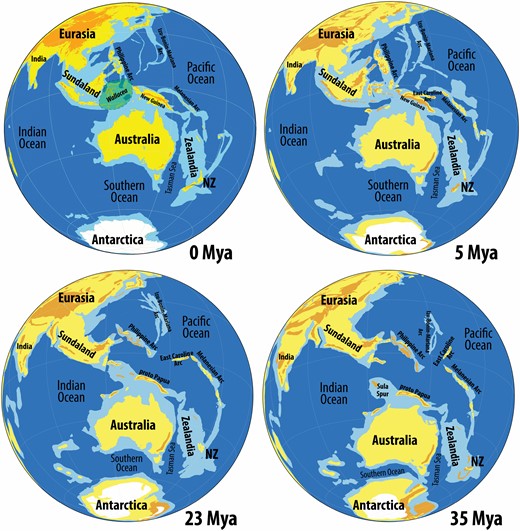Jim LeNomenclatoriste
Je suis un mignon petit Traquet rubicole

Yes, but its position varies in the two treesIs there a good study of Columba that includes Lemon Dove?

Yes, but its position varies in the two treesIs there a good study of Columba that includes Lemon Dove?


Citation?Yes, but its position varies in the two trees

Citation?


Oligo-Miocene radiation within South-west Pacific arc terranes underpinned repeated upstream continental dispersals in pigeons (Columbiformes)
Abstract. Upstream colonizations from islands to continents have played an important role in two major global bird radiations: the oscine passerines and thacademic.oup.com

I'd be a bit cautious about it.
First, this is based only on a cyt-b sequence -- this is the only gene that has been sequenced for Columba larvata.
Second, there are five cyt-b sequences for this species in GenBank (4 from Valente et al 2020, and a shorter one from Wilson et al 2022). Four of these are very similar to one another, while the fifth one is rather (~5%) divergent (and has quite a few unidentified nucleotides) -- this sequence might conceivably be problematic. Unfortunately, this divergent sequence is also the longest of the five, and is the one that Oliver et al 2023 chose to use in their supermatrix.
There was no good reason to include Aplopelia in Columba in the first place.What do you think of Jade Bruxaux’s study, which included Aplopelia larvata ?
Phylogeny and evolution of pigeons and doves (Columbidae) at different space and time scales
Pigeons and doves (Columbidae) belong to a species-rich worldwide-distributed family and are of major historical and ecological importance. We generated phylogenetic hypotheses from museum samples to clarify the diversification of the family, which probably took place between mid-Eocene and...hal.ird.fr
What do you think of Jade Bruxaux’s study, which included Aplopelia larvata ?
Phylogeny and evolution of pigeons and doves (Columbidae) at different space and time scales
Pigeons and doves (Columbidae) belong to a species-rich worldwide-distributed family and are of major historical and ecological importance. We generated phylogenetic hypotheses from museum samples to clarify the diversification of the family, which probably took place between mid-Eocene and...hal.ird.fr


+ NubotisI've now finished up (for now) the Columbiformes, and have moved into bustards and turacos
Otidiformes
Otididae
Lissotis, Ardeotis, Tetrax, Otis, Chlamydotis, Houbaropsis, Sypheotides, Lophotis, Heterotetrax, Eupodotis, and Afrotis
Yes obviouslyI am sure Jim will hate the way I break down Musophaginae,
Otidiformes
Otididae
Lissotis, Ardeotis, Tetrax, Otis, Chlamydotis, Houbaropsis, Sypheotides, Lophotis, Heterotetrax, Eupodotis, and Afrotis
This is pretty much the TiF breakdown so not many surprises here. Wikipedia for some reason puts these in subfamilies as well, but I am not sure the basis of this and I haven't seen subfamilies used in other classifications as far as I can tell.
The subfamilies are from Verheyen (1957), when Otididae was part of Ralliformes. Can't find Lissotinae or Neotinae anywhere else except as synonyms of Otididae or on Wikipedia derived sites.
Verheyen, R. 1957. Contribution au démembrement de l’ordo artificiel des Gruiformes (Peters 1934). 1. Les Ralliformes. Bull. 33(21): 1-44
In other papers in the series on Gruiformes he had orders Cariamiformes and Jacaniformes, the latter for Rhynochetidae, Eurypigidae, and Jacanidae. I wonder what he did with mesites.


Are there arguments in favor of splitting the family?I've more focused on the subspecies group portion of the project but I am continuuing to work on my overall bird checklist. I HAVE gotten through Cuculiformes and nocturnal Strisores, but haven't posted much since the former is pretty non-controversial and I am sort of still in the process of revising the latter
Here's at least the Cuculiformes
Cuculiformes
Crotophagidae
Crotophaginae
Guira, Crotophaga
Neomorphinae
Tapera, Dromococcyx, Morococcyx, Geococcyx, Neomorphus
Centropodidae
Couinae
Carpococcyx, Coua
Centropodinae
Centropus
Cuculidae
Rhinorthinae
Rhinortha
Phaenicophaeinae
Ceuthmochares, Taccocua, Zanclostomus, Phaenicophaeus, Rhamphococcyx, Dasylophus, Clamator, Coccycua, Piaya, Coccyzus
Cuculinae
Pachycoccyx, Eudynamys, Microdynamis, Scythrops, Urodynamis, Nannococcyx, Chrysococcyx, Cacomantis, Cercococcyx, Surniculus, Hierococcyx, Cuculus
Which one? Crotophagidae or Cuculidae? Do you mean is it worth splitting either into subfamilies?Are there arguments in favor of splitting the family?

All of themWhich one?

Crotophagidae has the strongest support...molecular clock data shows they split off VERY early from the other cuckoos, around ~40 million years ago, to the point that they are one of the few groups that bird-phylogeny.de, whose time-focused classification which tends to lump things actually suggest splitting them off. Both the main subfamilies here feel pretty distinctive to me. I've also seen some comments from SACC members to the effect that this could be an actual change that gets implemented some dayAre there arguments in favor of splitting the family?

Ah! Could you put his comments here if possible?I've also seen some comments from SACC members to the effect that this could be an actual change that gets implemented some day
